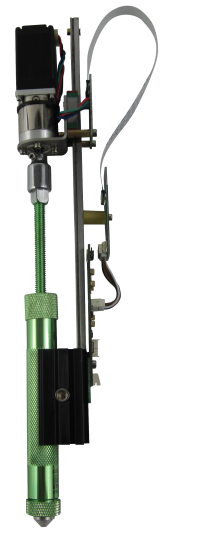Difference between revisions of "EMO"
| Line 5: | Line 5: | ||
|} | |} | ||
The | The EMO-25 is our 25cc print head for medium viscosity emulsions which print at room temperature. | ||
[[File: | [[File:EMO-25.png|200px|left|EMO-25]] | ||
This includes the following materials: | This includes the following materials: | ||
<div style="column-count:3;-moz-column-count:3;-webkit-column-count:3"> | <div style="column-count:3;-moz-column-count:3;-webkit-column-count:3"> | ||
* | *Clays | ||
* | *Pastes | ||
* | *Emulsions | ||
</div> | </div> | ||
== Videos == | == Videos == | ||
# | # Overview of Cold and Warm Flow Print Heads: | ||
* [[File:Yt.png]] [https://www.youtube.com/watch?v=ktK256u0sN8 Overview of the EMO and COD Heads] | |||
# Loading and Printing Tips: | |||
* [[File:Yt.png]] [https://www.youtube.com/watch?v=tLHpaePTP-k EMO Series Printing Tips] | |||
* [[File:Yt.png]] [https://www.youtube.com/watch?v=4yuzpUqeE-Y Loading the EMO-25] | |||
* [[File:Yt.png]] [https://www.youtube.com/watch?v=IEmQJxlPnuY More Loading the EMO-25] | |||
* [[File:Yt.png]] [https://www.youtube.com/watch?v=q-DbAbNMW48 Loading and Printing with the EMO-25] | |||
== Description == | == Description == | ||
* The EMO-25 has a 25cc anodized aluminum reservoir with a threaded collar at each end. The top has a threaded rod, which is how material is displaced; the bottom holds a nozzle, or a nozzle or luer adapter. Industry standard luer tips or needles are available from a variety of sources. | |||
== Loading the Head onto the Printer == | == Loading the Head onto the Printer == | ||
| Line 47: | Line 44: | ||
== Loading material into the Head == | == Loading material into the Head == | ||
Loading: | |||
* Care should be taken to avoid air pockets, as this will introduce delay when starting and stopping material flow. | |||
Unloading: | Unloading: | ||
* Unloading is the same process as loading, only in reverse. Tubes and nozzles should be cleaned thoroughly after use. | |||
== Default Parameters == | == Default Parameters == | ||
Default settings for all MK series heads are shown on the [[ | Default settings for all MK series heads are shown on the [[Cold_and_Warm_Flow]] page. | ||
== Adjustments == | == Adjustments == | ||
The only adjustments needed should be changes to the PRIME and UNPRIME settings, and | The only adjustments needed should be changes to the PRIME and UNPRIME settings, and will have to be dialed in based on how viscous and compressible your material is, and how narrow a nozzle or luer tip you are using.. In dialing in new settings, I usually double or half the settings for both STEPS and TIME, then make another print and reassess. | ||
== Firmware == | == Firmware == | ||
Please see the [[Downloads]] page for the current firmware for your heads and your version of Repetrel. | |||
== Maintenance == | == Maintenance == | ||
While cleaning your print media from the tube and nozzle after every print is important, very little other maintenance is required on this head. | |||
Revision as of 16:31, 1 April 2017
The EMO-25 is our 25cc print head for medium viscosity emulsions which print at room temperature.
This includes the following materials:
- Clays
- Pastes
- Emulsions
Videos
- Overview of Cold and Warm Flow Print Heads:
- Loading and Printing Tips:
 EMO Series Printing Tips
EMO Series Printing Tips Loading the EMO-25
Loading the EMO-25 More Loading the EMO-25
More Loading the EMO-25 Loading and Printing with the EMO-25
Loading and Printing with the EMO-25
Description
- The EMO-25 has a 25cc anodized aluminum reservoir with a threaded collar at each end. The top has a threaded rod, which is how material is displaced; the bottom holds a nozzle, or a nozzle or luer adapter. Industry standard luer tips or needles are available from a variety of sources.
Loading the Head onto the Printer
As with all Hyrel heads, the following process should be followed:
- Start with a level bed and Repetrel running and connected to the printer.
- Load the gibs on the Head into the gib slots on the Yoke from above and slide the head down into place; the last mm of travel should be done gently, ensuring that the electrical connector seats properly (firmly and completely) into the receiving connector.
- Ensure the LEDs on the print head are flashing - this means the Head is communicating with the Motion Controller.
- Tighten the thumbscrew in the rear, to prevent the head from moving relative to the Yoke.
- If the Head doesn't show up in Repetrel, press and release the RESET button on the front of the printer.
- Once the Head is shown in repetrel, proceed to setting your Z-Zero position.
Loading material into the Head
Loading:
- Care should be taken to avoid air pockets, as this will introduce delay when starting and stopping material flow.
Unloading:
- Unloading is the same process as loading, only in reverse. Tubes and nozzles should be cleaned thoroughly after use.
Default Parameters
Default settings for all MK series heads are shown on the Cold_and_Warm_Flow page.
Adjustments
The only adjustments needed should be changes to the PRIME and UNPRIME settings, and will have to be dialed in based on how viscous and compressible your material is, and how narrow a nozzle or luer tip you are using.. In dialing in new settings, I usually double or half the settings for both STEPS and TIME, then make another print and reassess.
Firmware
Please see the Downloads page for the current firmware for your heads and your version of Repetrel.
Maintenance
While cleaning your print media from the tube and nozzle after every print is important, very little other maintenance is required on this head.
